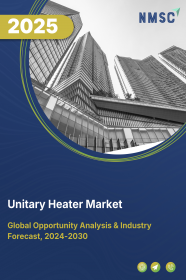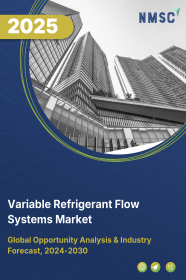
Ventilation System Market by Ventilation Type (Natural Ventilation, Heat Recovery Ventilation, & Others), by Product Type (Ventilation Fans, Air Handling Units (AHUs), and Others), by Technology (Centralized Ventilation, and Others), by Application (Ventilation and Air Conditioning (HVAC) Systems, & Others), and by End Users (Residential, Commercial (Offices, and Data Centers), & Others)) –Global Opportunity Analysis and Industry Forecast 2025-2030
US Tariff Impact on Ventilation System Market
Trump Tariffs Are Reshaping Global Business
Ventilation System Industry Overview
The global Ventilation System Market size was valued at USD 29.65 billion in 2024 and is predicted to reach USD 31.92 billion by the end of 2025. The industry is predicted to reach USD 46.24 billion by 2030 with a CAGR of 7.7% from 2026-2030.
The market is growing due to increasing awareness of indoor air quality and its impact on health, stringent regulations, and the rise of industrialization and urbanization. As concerns about pollutants and airborne viruses grow, the demand for efficient ventilation solutions increases across various sectors.
Regulatory requirements for better air quality and energy efficiency are fueling market expansion. However, high initial costs remain a barrier, particularly in price-sensitive markets. Technological advancements, such as energy-efficient systems, smart controls, and improved filtration, offer significant opportunities for growth, enabling innovation and sustainability in the market.
Increasing Awareness of Indoor Air Quality and Health Impacts Drives the Ventilation System Market Growth
One of the primary forces propelling the sector forward is the increasing awareness and understanding of the critical link between indoor air quality (IAQ) and human health. Whether it's in residential, commercial, or industrial settings, people are becoming more conscious of the pollutants, allergens, and even airborne viruses that can accumulate indoors. Proper ventilation plays a vital role in diluting and removing these contaminants, contributing to healthier and more productive environments.
For instance, in industrial facilities, effective industrial ventilation is crucial for controlling dust, fumes, and harmful gases, safeguarding the health of workers. This growing health consciousness is directly translating into a greater demand for efficient and reliable ventilation solutions across various sectors.
Stringent Regulations and Building Codes Boosts the Growth of the Market
Stringent regulations and building codes around the globe are acting as a significant catalyst for the industry. Governments and regulatory bodies are increasingly mandating minimum ventilation rates and standards to ensure healthy indoor environments and improve energy efficiency. These regulations often specify requirements for air exchange rates, filtration, and the types of ventilation systems to be installed in new constructions and sometimes even retrofitted in existing buildings. This regulatory push creates a consistent and growing demand for ventilation products and services.
For example, building codes might require the installation of mechanical ventilation systems in energy-efficient homes to ensure adequate fresh air supply when natural ventilation is limited. Compliance with these standards is not just a legal necessity but also a driver for market growth.
Rapid Industrialization and Urbanization Drives the Ventilation System Market Demand
The relentless pace of industrialization and urbanization worldwide is another powerful engine driving the market. The establishment of new manufacturing plants, factories, and commercial buildings in urban centers necessitates robust industrial ventilation systems to manage air quality challenges associated with industrial processes, such as heat, humidity, dust, and chemical emissions.
Simultaneously, increasing population density in urban areas leads to the construction of more residential and commercial spaces, all requiring effective ventilation for the well-being of occupants. The growth in these sectors directly correlates with an increased demand for a wide range of ventilation solutions, contributing significantly to the overall market size and growth potential of the ventilation industry.
High Initial Investment Costs Hinders the Market Growth
The key restraints on the broader adoption of advanced ventilation systems, particularly in price-sensitive markets or for individual homeowners, is the often-high initial investment cost. While the long-term benefits of energy efficiency and improved health are recognized, the upfront expense of purchasing and installing sophisticated mechanical ventilation systems, especially those with heat recovery or smart controls, can be a deterrent.
This cost factor can influence the choice of ventilation solutions, sometimes leading to the selection of less efficient or less comprehensive systems. Overcoming this barrier might require government incentives, technological innovations that lower manufacturing costs, or greater consumer awareness of the long-term savings and health benefits that outweigh the initial expenditure.
Technological Advancements and Innovations in Ventilation Systems Creates Market Opportunities
A significant opportunity for players in the market lies in continuous technological advancements and innovations. This includes the development of more energy-efficient fans and motors, sophisticated filtration technologies, smart sensors and controls for demand-controlled ventilation, and personalized ventilation solutions. Innovations are also emerging in corrosion-resistant materials for harsh industrial environments and the integration of ventilation systems with renewable energy sources.
By investing in research and development and bringing these cutting-edge technologies to the market, industry players can differentiate themselves, capture greater market share, and address evolving customer needs for more efficient, sustainable, and healthier indoor environments.
For instance, Nihon Kohden America, in October 2024, launched the NKV-440 Ventilator System, a hybrid ventilator for broader healthcare applications, enhancing accessibility and efficiency. These advancements are crucial for unlocking further growth potential in the ventilation industry.
Market Segmentation and Scope of the Study
The ventilation system market report is segmented by ventilation type, product, technology, application, and end user. By ventilation type, the market includes natural ventilation, heat recovery ventilation, and mechanical ventilation. By product, it comprises ventilation fans, air handling units (AHUs), heat recovery systems, exhaust systems, air conditioning systems, and others. Ventilation fans is further divided into axial fans, centrifugal fans, mixed flow fans, and cross flow fans. Heat recovery systems is further divided into plate heat exchangers, rotary heat exchangers, run-around coil systems, and heat pipes. Exhaust systems is further divided into kitchen exhaust systems, bathroom exhaust systems, and industrial exhaust systems. By technology, the market is divided into centralized ventilation, decentralized ventilation, and range hoods. By application, it includes ventilation and air conditioning (HVAC) systems, industrial process ventilation, indoor air quality (IAQ) management, smoke and fire management, and others. By end user, the market is segmented into residential, commercial, and industrial. The commercial segment is further divided into offices, retail spaces, hospitality, education institutions, healthcare facilities, and data centers. The industrial segment is further divided into manufacturing facilities, chemical plants, warehouses, mining, power generation, automotive, and others. Regional breakdown and analysis of each of the aforesaid segments include regions comprising North America, Europe, Asia-Pacific, and RoW.
Geographical Analysis
Asia-Pacific is demonstrating significant growth potential in the ventilation system market share due to rapid industrialization and urbanization, leading to increased demand in both industrial and commercial sectors. Factors like growing awareness of indoor air quality (IAQ) and rising disposable incomes are also contributing to a larger market size in this region.
In North America and Europe, the market is mature but driven by stringent regulations concerning energy efficiency and IAQ, pushing the demand for advanced and energy-efficient ventilation technologies. These regions also show a growing interest in smart and connected ventilation systems for enhanced control and energy savings.
The Rest of the World region, encompassing areas like Latin America, the Middle East, and Africa, presents varying levels of market development, with potential driven by increasing construction activities and a gradual rise in awareness regarding the importance of ventilation, though specific details on market share and growth potential might vary significantly within this diverse region. Overall, the global ventilation industry size is substantial, with each region presenting unique dynamics and opportunities.
Strategic Innovations Adopted by Key Players
Leading players in the global ventilation system industry are strategically focusing on technological advancements to capture greater market share and address evolving consumer needs. A key development involves the integration of smart and connected ventilation systems, allowing for optimized performance and energy efficiency.
For instance, Panasonic launched the WhisperGreen Select ventilation fans in April 2024, featuring Dual Sensor Technology and Wi-Fi connectivity for smart, energy-efficient indoor air quality control. Companies are also investing in sensors and controls that enable demand-controlled ventilation, adjusting airflow based on occupancy and air quality, thus reducing unnecessary energy consumption.
Another significant trend is the development of more energy-efficient ventilation solutions, driven by increasing energy costs and environmental concerns. Greenheck, for example, introduced the XG TH 500 air terminal unit in July 2023, optimizing airflow and energy efficiency for commercial and industrial applications. This includes innovations in fan designs and heat recovery technologies.
Furthermore, there's a growing emphasis on personalized ventilation systems, allowing individuals to control their immediate environment. However, these players face challenges such as the high initial investment costs associated with advanced systems, which can hinder wider adoption, particularly in price-sensitive markets.
Key Benefits
-
The report provides quantitative analysis and estimations of the market from 2025 to 2030, which assists in identifying the prevailing market opportunities.
-
The study comprises a deep dive analysis of the current and future ventilation system market trends to depict prevalent investment pockets in the market.
-
Information related to key drivers, restraints, and opportunities and their impact on the ventilation system sector is provided in the report.
-
Competitive analysis of the players, along with their market share is provided in the report.
-
SWOT analysis and Porters Five Forces model is elaborated in the study.
-
Value chain analysis in the market study provides a clear picture of roles of stakeholders.
Ventilation System Market Key Segments
By Ventilation Type
-
Natural Ventilation
-
Heat Recovery Ventilation
-
Mechanical Ventilation
By Product
-
Ventilation Fans
-
Axial Fans
-
Centrifugal Fans
-
Mixed Flow Fans
-
Cross Flow Fans
-
-
Air Handling Units (AHUs)
-
Heat Recovery Systems
-
Plate Heat Exchangers
-
Rotary Heat Exchangers
-
Run-Around Coil Systems
-
Heat Pipes
-
-
Exhaust Systems
-
Kitchen Exhaust Systems
-
Bathroom Exhaust Systems
-
Industrial Exhaust Systems
-
-
Air Conditioning Systems
-
Others
By Technology
-
Centralized Ventilation
-
Decentralized Ventilation
-
Range Hood
By Application
-
Ventilation and Air Conditioning (HVAC) Systems
-
Industrial Process Ventilation
-
Indoor Air Quality (IAQ) Management
-
Smoke and Fire Management
-
Others
By End User
-
Residential
-
Commercial
-
Offices
-
Retail Spaces
-
Hospitality
-
Education Institutions
-
Healthcare Facilities
-
Data Centers
-
-
Industrial
-
Manufacturing Facilities
-
Chemical Plants
-
Warehouses
-
Mining
-
Power Generation
-
Automotive
-
Others
-
By Region
-
North America
-
The U.S.
-
Canada
-
Mexico
-
-
Europe
-
The UK
-
Germany
-
France
-
Italy
-
Spain
-
Denmark
-
Netherlands
-
Finland
-
Sweden
-
Norway
-
Russia
-
Rest of Europe
-
-
Asia Pacific
-
China
-
Japan
-
India
-
South Korea
-
Australia
-
Indonesia
-
Singapore
-
Taiwan
-
Thailand
-
Rest of Asia Pacific
-
-
RoW
-
Latin America
-
Middle East
-
Africa
-
Key Players
-
Honeywell International Inc.
-
Mitsubishi Electric Corporation
-
Johnson Controls
-
Midea Group Ltd.
-
Daikin Industries Ltd.
-
Lennox International Inc.
-
Panasonic Holdings Corporation
-
LG Electronics Inc.
-
Emerson Electric Co.
-
Komfovent Ltd.
-
Carrier Global Corporation
-
Trane Technologies plc
-
Systemair AB
-
Greenheck Fan Corporation
-
Ebm-Papst Group
REPORT SCOPE AND SEGMENTATION
|
Parameters |
Details |
|
Market Size in 2024 |
USD 29.65 billion |
|
Revenue Forecast in 2030 |
USD 46.24 billion |
|
Growth Rate |
CAGR of 7.7% from 2026 to 2030 |
|
Analysis Period |
2024–2030 |
|
Base Year Considered |
2024 |
|
Forecast Period |
2025–2030 |
|
Market Size Estimation |
Billion (USD) |
|
Growth Factors |
|
|
Countries Covered |
28 |
|
Companies Profiled |
15 |
|
Market Share |
Available for 10 companies |
|
Customization Scope |
Free customization (equivalent up to 80 working hours of analysts) after purchase. Addition or alteration to country, regional, and segment scope. |
|
Pricing and Purchase Options |
Avail customized purchase options to meet your exact research needs. |

















 Speak to Our Analyst
Speak to Our Analyst





















